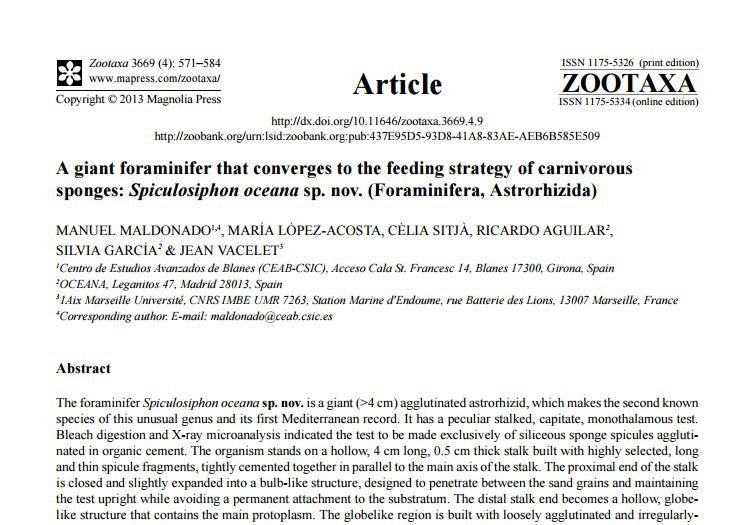Report | junio 12, 2013
A giant foraminifer that converges to the feeding strategy of carnivorous sponges: Spiculosiphon oceana sp. nov. (Foraminifera, Astrorhizida)

The foraminifer Spiculosiphon oceana sp. nov. is a giant (>4 cm) agglutinated astrorhizid, which makes the second known species of this unusual genus and its first Mediterranean record. It has a peculiar stalked, capitate, monothalamous test. Bleach digestion and X-ray microanalysis indicated the test to be made exclusively of siliceous sponge spicules aggluti-nated in organic cement. The organism stands on a hollow, 4 cm long, 0.5 cm thick stalk built with highly selected, long and thin spicule fragments, tightly cemented together in parallel to the main axis of the stalk. The proximal end of the stalk is closed and slightly expanded into a bulb-like structure, designed to penetrate between the sand grains and maintaining the test upright while avoiding a permanent attachment to the substratum. The distal stalk end becomes a hollow, globe-like structure that contains the main protoplasm. The globelike region is built with loosely agglutinated and irregularly-shaped spicules, allowing extrusion of the pseudopodia through the cavities between the spicules. The globelike structure also serves as an anchoring basis, from which long and thin, solid tracts protrude radially to make a spherical crown that attains about 4 mm in total diameter. The radiating tracts are built with highly selected aciculate spicule fragments held together with a translucent organic cement. They provide skeletal support for the extension of a crown of pseudopodia into the water column. This arrangement is thought to enhance the chances of the pseudopodia to contact demersal planktonic prey. In summary, Spiculosiphon species collect and arrange sponge spicules with high selectivity to recreate a body mor-phology that strongly converges to that of some carnivorous sponges, which allows these predatory foraminifera to exploit a prey capturing strategy similar to that of the carnivorous sponges. This idea is also consistent with our report of an ad-ditional, yet undetermined, Spiculosiphon species occurring in the same sublittoral Mediterranean cave where carnivorous sponges were first discovered.

